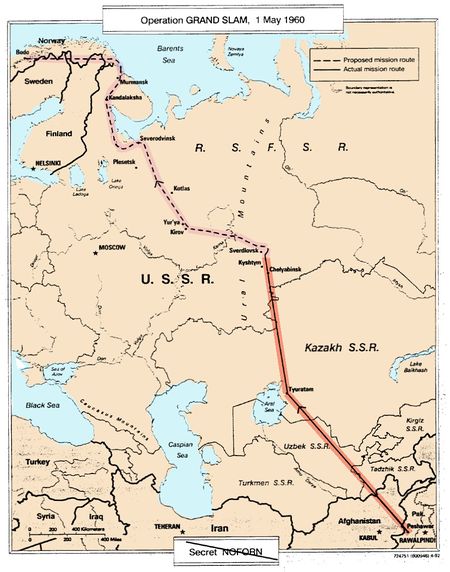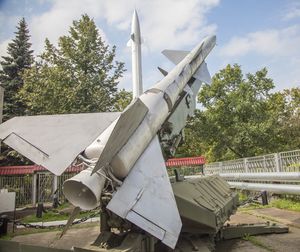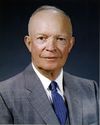حادثة طائرة التجسس الأمريكية يو-2، 1960
| U-2 incident of 1960 | |
|---|---|
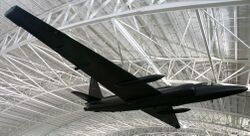 | |
| الموقع | بالقرب من أراميل، أوبلاست سڤردلوڤسك، الاتحاد السوڤيتي[1] |
| الإحداثيات | 56°43′35.73″N 60°59′9.61″E / 56.7265917°N 60.9860028°E |
| التاريخ | 1 مايو 1960 |
| Attack type | إسقاط طائرة |
| القتلى | 1 سوڤيتي (نيران صديقة) |
في 1 مايو 1960 ، تم إسقاط طائرة تجسس يو-2 من قبل قوات الدفاع الجوي السوڤياتي أثناء أداء التصوير الفوتوغرافي استطلاع جوي عميقًا في الأراضي السوڤيتية. وأصيبت الطائرة ذات المقعد الواحد ، التي حلّق بها الطيار فرانسيس گاري پاورز، بـصاروخ أرض-جو إس -75 دڤينا (التوجيهي SA-2) وتحطمت بالقرب من سڤيردلوڤسك (اليوم يكاترينبورگ). هبط پاورز بالمظلة بأمان وتم القبض عليه.
في البداية ، اعترفت السلطات الأمريكية بالحادث باعتباره خسارة لطائرة بحثية عن الطقس مدنية تديرها ناسا ، لكنها اضطرت إلى الاعتراف بالغرض الحقيقي للبعثة عندما قامت الحكومة السوڤيتية بعد بضعة أيام بتقديم الطيار الذي تم القبض عليه وأجزاء من معدات المراقبة الخاصة بـ يو-2 ، بما في ذلك صور القواعد العسكرية السوڤيتية التي تم التقاطها أثناء المهمة.
وقع الحادث أثناء رئاسة دوايت د.أيزنهاور ورئيس الوزراء نيكيتا خروتشوڤ ، قبل حوالي أسبوعين من الافتتاح المقرر لقمة الشرق والغرب في باريس. تسبب في إحراج كبير للولايات المتحدة ودفع إلى تدهور ملحوظ في العلاقات مع الاتحاد السوڤيتي ، والتي توترت بالفعل بسبب الحرب الباردة الجارية.[2]
أُدينت الصلاحيات بـ التجسس وحُكم عليه بالسجن ثلاث سنوات بالإضافة إلى سبع سنوات من الأشغال الشاقة ولكن أُفرج عنه بعد ذلك بسنتين في 10 فبراير 1962 خلال تبادل الأسرى للسوڤييت للضابط رودولف هابيل.[3]
خلفية
في يوليو 1958 ، طلب الرئيس الأمريكي دوايت د. إيزنهاور إذنًا من رئيس الوزراء الپاكستاني للولايات المتحدة لإنشاء مرفق استخبارات سري في پاكستان ول يو-2 طائرة التجسس للسفر من پاكستان. طارت يو-2 على ارتفاعات لم تتمكن الطائرات المقاتلة السوڤيتية من الوصول إليها في تلك الحقبة. كان يعتقد أنها كانت بعيدًة عن متناول الصواريخ السوڤيتية أيضًا. تم إنشاء المنشأة في بادابر (محطة پيشاور الجوية) ، 10 ميل (16 km) من پيشاور ، التي كانت بمثابة غطاء لعملية اعتراض اتصالات رئيسية تديرها الأمم المتحدة الولايات وكالة الأمن القومي (NSA). كانت بادابر موقعًا ممتازًا نظرًا لقربها من آسيا الوسطى السوڤيتية. وقد مكّن هذا من رصد مواقع اختبار الصواريخ والبنية التحتية الرئيسية والاتصالات. سمح لطائرة يو-2 "spy-in-the-sky" باستخدام قسم القوات الجوية الپاكستانية من مطار پيشاور للحصول على ذكاء حيوي في عصر ما قبل رصد الأقمار الصناعية.[4]
لم يرغب الرئيس أيزنهاور في قيادة طيارين أمريكيين من طراز يو-2 فوق الاتحاد السوڤييتي لأنه شعر أنه إذا تم إسقاط أو القبض على أحد هؤلاء الطيارين ، فيمكن اعتباره بمثابة عمل عدواني. في وقت مثل الحرب الباردة ، يمكن لأي عمل عدواني أن يشعل نزاعًا مفتوحًا بين البلدين. ولتخفيف عبء نقل الأمريكيين إلى المجال الجوي السوفيتي ، تطورت الفكرة لجعل الطيارين البريطانيين من القوات الجوية الملكية يطيرون في هذه المهام بدلاً من وكالة المخابرات المركزية الأمريكية (CIA). مع استمرار المملكة المتحدة في الانهيار من آثار أزمة السويس وعدم قدرتها على تجاهل الطلبات الأمريكية ، كانت الحكومة البريطانية على استعداد لهذا الاقتراح. سمح استخدام الطيارين البريطانيين لأيزنهاور بالتمكن من استخدام طائرة يو-2 لمعرفة ما كان يخفيه الاتحاد السوڤييتي ، بينما لا يزال قادرًا على إنكار أي انتماء إذا تعرضت المهمة للخطر.
بعد نجاح الطيارين البريطانيين الأولين وبسبب الضغط لتحديد عدد الصواريخ البالستية العابرة للقارات السوڤييتية بشكل أكثر دقة ، سمح آيزنهاور بتحليق مهمتين أخريين قبل قمة القوى الأربعة في باريس ، المقرر عقدها في 16 مايو. وستنقل الطائرتان الأمريكيتان آخر مهمتين قبل القمة.[5]
في 9 أبريل 1960 ، عبرت طائرة تجسس يو-2سي لوحدة وكالة المخابرات المركزية الخاصة "10-10" ، التي يقودها بوب إريكسون ، الحدود الوطنية الجنوبية للاتحاد السوڤيتي في منطقة جبال پامير وحلقت فوق أربعة الأهداف العسكرية السوڤياتية السرية للغاية: موقع اختبار سيميپالاتينسك ، قاعدة دولون الجوية حيث تمركز تو -95 قاذفات القنابل الاستراتيجية ، سطح صاروخ جو-جو (SAM) موقع اختبار قوات الدفاع الجوي السوڤييتي بالقرب من ساريشاگان ، ونطاق صواريخ تايراتام (قاعدة بايكونور الفضائية).[6]
تم الكشف عن الطائرة من قبل قوات الدفاع الجوي السوڤييتية عندما كانت تحلق أكثر من 250 كيلومتر (155 mi) فوق الحدود الوطنية السوڤيتية وتجنبت عدة محاولات للاعتراض بواسطة ميگ-19 و سو-9 أثناء الرحلة. غادرت يو-2 المجال الجوي السوڤييتي وهبطت في مهبط طائرات إيراني في زاهدان. كان من الواضح أن وكالة المخابرات المركزية الأمريكية قد نجحت في تنفيذ عملية استخبارية استثنائية. تم التخطيط للرحلة التالية لطائرة التجسس يو-2 من مطار پيشاور في أواخر أبريل.[6]
الحدث
On 28 April 1960, a U.S. Lockheed U-2C spy plane, Article 358, was ferried from Incirlik Air Base in Turkey to the US base at Peshawar airport by pilot Glen Dunaway. Fuel for the aircraft had been ferried to Peshawar the previous day in a US Air Force C-124 transport. A US Air Force C-130 followed, carrying the ground crew, mission pilot Francis Powers, and the back up pilot, Bob Ericson. On the morning of 29 April, the crew in Badaber was informed that the mission had been delayed one day. As a result, Bob Ericson flew Article 358 back to Incirlik and John Shinn ferried another U-2C, Article 360,[7] from Incirlik to Peshawar. On 30 April, the mission was delayed one day further because of bad weather over the Soviet Union.[6]
The weather improved and on 1 May, 15 days before the scheduled opening of the east–west summit conference in Paris, Captain Powers, flying Article 360, 56–6693 left the base in Peshawar on a mission with the operations code word GRAND SLAM[8] to overfly the Soviet Union, photographing targets including the ICBM sites at the Baikonur Cosmodrome and Plesetsk Cosmodrome, then land at Bodø in Norway. At the time, the USSR had six ICBM launch pads, two at Baikonur and four at Plesetsk.[9] Mayak, then named Chelyabinsk-65, an important industrial center of plutonium processing, was another of the targets that Powers was to photograph.[10] A close study of Powers's account of the flight shows that one of the last targets he overflew, before being shot down, was the Chelyabinsk-65 plutonium production facility.[11]
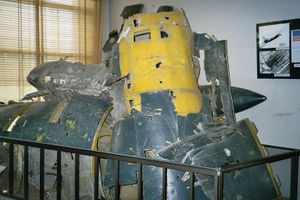
The U-2 flight was expected, and all units of the Soviet Air Defence Forces in the Central Asia, Kazakhstan, Siberia, Ural, and later in the USSR European Region and Extreme North, were placed on red alert. Soon after the plane was detected, Lieutenant General of the Air Force Yevgeniy Savitskiy ordered the air-unit commanders "to attack the violator by all alert flights located in the area of foreign plane's course, and to ram if necessary".[12]
Because of the U-2's extreme operating altitude, Soviet attempts to intercept the plane using fighter aircraft failed. The U-2's course was out of range of several of the nearest SAM sites, and one SAM site even failed to engage the aircraft since it was not on duty that day. The U-2 was eventually brought down near Kosulino, Ural Region, by the first of three SA-2 Guideline (S-75 Dvina) surface-to-air missiles[13] fired by a battery commanded by Mikhail Voronov.[6] The SA-2 site had been previously identified by the CIA, using photos taken during Vice President Richard Nixon's visit to Sverdlovsk the previous summer.[14][15]
Powers bailed out but neglected to disconnect his oxygen hose first and struggled with it until it broke, enabling him to separate from the aircraft. After parachuting safely down onto Russian soil, Powers was quickly captured.[12] Powers carried with him a modified silver dollar which contained a lethal, shellfish-derived saxitoxin-tipped needle, but he did not use it.[16]
The SAM command center was unaware that the plane was destroyed for more than 30 minutes.[12] One of the Soviet MiG-19 fighters pursuing Powers was also destroyed in the missile salvo, and the pilot, Sergei Safronov, was killed.[6][17] The MiGs' IFF transponders were not yet switched to the new May codes because of the 1 May holiday.[18]
التغطية الأمريكية والانكشاف
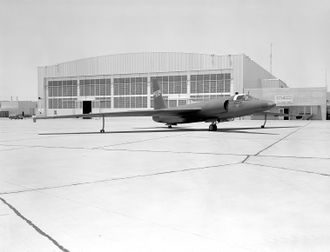
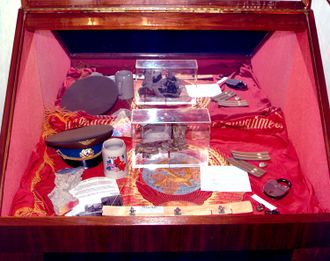
Four days after Powers' disappearance, NASA issued a very detailed press release noting that an aircraft had "gone missing" north of Turkey.[3] The press release speculated that the pilot might have fallen unconscious while the autopilot was still engaged, even falsely claiming that "the pilot reported over the emergency frequency that he was experiencing oxygen difficulties." To bolster this, a U-2 plane was quickly painted in NASA colors and shown to the media. Under the impression that the pilot had died and that the plane had been destroyed, the Americans had decided to use the NASA cover-up plan.[19] Nikita Khrushchev used the American misstep to embarrass President Eisenhower and his administration.
That same day on 5 May, the Senate made its first comments on the U-2 incident, and began a domestic political controversy for Eisenhower. Mike Mansfield, the Senate Majority Whip, stated, "First reports indicate that the President had no knowledge of the plane incident. If that is the case, we have got to ask whether or not this administration has any real control over the federal bureaucracy."[20] Mansfield, more than any other person, highlighted the dilemma Eisenhower faced—Eisenhower could admit responsibility for the U-2 flight, and likely ruin any chances for détente at the Paris Summit, or he could continue to deny knowledge and indicate that he did not control his own administration.[21]
After Khrushchev found out about America's NASA cover story, he developed a political trap for Eisenhower. His plan began with the release of information to the world that a spy plane had been shot down in Soviet territory, but he did not reveal that the pilot of this plane had also been found and that he was alive. With the information that Khrushchev released, the Americans believed that they would be able to continue with their cover story that the crashed plane was a weather research aircraft and not a military spy plane. The cover-up said that the pilot of the U-2 weather plane had radioed in that he was experiencing oxygen difficulties while flying over Turkey. From there they claimed that the plane could have continued on its path because of auto-pilot, and that this could be the plane that crashed in the Soviet Union. The final attempt to make the cover story seem as real as possible was the grounding of all U-2 planes for mandatory inspection of oxygen systems in order to make sure that no other "weather missions" would have the same result as the one that was lost and possibly crashed in the Soviet Union.[22]
On 7 May, Khrushchev sprang his trap and announced:[11]
I must tell you a secret. When I made my first report I deliberately did not say that the pilot was alive and well ... and now just look how many silly things the Americans have said.
Also, because of the release of some photographs of the plane, there was evidence that most of the covert U-2 technologies had survived the crash. From this Khrushchev was able to openly embarrass the Eisenhower administration by exposing the attempted cover-up.[23]
Khrushchev still attempted to allow Eisenhower to save face, possibly to salvage the peace summit to some degree, by specifically laying the blame not on Eisenhower himself, but on Director of Central Intelligence Allen Dulles and the CIA: Khrushchev said that anyone wishing to understand the U-2's mission should "seek a reply from Allen Dulles, at whose instructions the American aircraft flew over the Soviet Union."[24] On 9 May, the Soviet premier told US ambassador Thompson that he "could not help but suspect that someone had launched this operation with the deliberate intent of spoiling the summit meeting." Thompson also wrote in his diplomatic cable that Khrushchev suspected it was Allen Dulles, and that Khrushchev had heard about Senator Mansfield's remarks that Eisenhower did not control his own administration.[25]
Upon receiving this cable, Eisenhower, who frequently was very animated, was quiet and depressed. The only words he said to his secretary were, "I would like to resign."[26] Meanwhile, the domestic pressure continued to mount. Eisenhower then accepted Dulles's argument that the congressional leadership needed to be briefed on the U-2 missions from the last four years. Dulles told the legislature that all U-2 flights were used for aerial espionage and had been flown pursuant to "presidential directives". Still, Dulles played down Eisenhower's direct role in approving every previous U-2 flight.[27]
The next day on 10 May, without consulting with any agency heads, House Appropriations Chair Clarence Cannon received considerable press attention when he, not President Eisenhower, revealed the true nature of the U-2 mission. He said to an open session of the House of Representatives that the U-2 was a CIA plane engaged in aerial espionage over the Soviet Union. Cannon said,
Mr. Chairman, on May 1 the Soviet Government captured, 1300 miles inside the boundaries of the Russian empire, an American plane, operated by an American pilot, under the direction and control of the U.S. Central Intelligence Agency, and is now holding both the plane and the pilot. The plane was on an espionage mission ... The activity ... [was] under the aegis of the Commander in Chief of the Armed Forces of the United States, for whom all members of the subcommittee have the highest regard and in whose military capacity they have the utmost confidence.[28]
At the end of Cannon's speech, Democrats and Republicans uncharacteristically rose to their feet to applaud.[29]
Still Eisenhower faced criticism in the press for not controlling his own administration, as Cannon's speech only said the mission was "under the aegis of" the president, not "directed by". Press reports were creating a belief in the public that Eisenhower had lost control, which Eisenhower would not let stand. Knowing that he was jeopardizing the Paris Peace Summit, Eisenhower decided to reveal the aerial espionage program and his direct role in it, an unprecedented move for a U.S. president. His speech on 11 May revolved around four main points: the need for intelligence gathering activities; the nature of intelligence gathering activities; how intelligence activities should be viewed (as distasteful, but vital); and finally that Americans should not be distracted from the real problems of the day. Eisenhower closed passionately by reacting to the Soviet claim that the US acted provocatively and said: "They had better look at their own [espionage] record." As he finished, he told reporters he was still going to the Paris Peace Summit.[30]
From the Congressional Research Service report "Covert Action: An Effective Instrument of U.S. Foreign Policy?", dated 21 October 1996, released by Wikileaks: "Many observers believed that when President Eisenhower in 1960 accepted responsibility for U-2 overflights of the Soviet Union, he made reaching agreements with Moscow much more difficult; had he blamed the flights on the Pentagon or the CIA, Khrushchev arguably might not have felt forced to react so strongly even though he might not believe the denials. Such reasoning, while constrained, is hardly unusual. It is easier for a President to deal with foreign leaders who are known to have committed violent acts, but have never admitted having done so, than to meet formally with those who have acknowledged 'unacceptable' behavior."[31]
Today a large part of the wreck as well as many items from Powers's survival pack are on display at the Central Armed Forces Museum in Moscow. A small piece of the plane was returned to the United States and is on display at the National Cryptologic Museum.[32]
المخابرات
Already from 1948, Norwegian Selmer Nilsen had been recruited by the Soviet intelligence organization GRU, amongst other foreigners, to spy on allied activity in NATO countries. Nilsen was assigned to watch allied military activity in northern Norway.[33] The U-2 operations were linked with the airport Bodø, which was one of its permanent stations. Selmer Nilsen recorded U-2 activity in Bodø and forwarded much military information to the Soviet Union. He was convicted for espionage in 1968 in a closed trial in Norway, with a penalty of seven years and six months' imprisonment. He was released after three years.
الأعقاب
ردود الأفعال المتزامنة مع حادثة يو-2 وأثرها على قمة القوى الأربع
The Summit was attended by Eisenhower, Khrushchev, French President Charles de Gaulle, and British Prime Minister Harold Macmillan.[34] It was the first conference to be attended by both Soviet and western leaders in five years.[35] However, prospects for constructive dialogue were dashed by the explosive controversy surrounding the U-2 flight over Soviet territory.
Although the Four Powers Summit was the first meeting between western and Soviet leaders in five years when it was held, the mood was optimistic that there could be an easing of tensions between the Soviet Union and the United States. In an effort to present a less hostile, more cordial Soviet Union, Khrushchev publicly advocated a policy of "peaceful coexistence with the United States."[35] The May Day celebrations on 1 May of that year were marked by this newfound cooperative spirit. Absent were the militarized symbols of previous parades, such as artillery and armor. Instead there were children, white doves, and athletes.[36] But the reaction of the Soviet government to the spy plane incident and the response from the United States doomed any potential meaningful peace agreement.[34]
In the days directly leading up to the conference, tensions increased dramatically between the United States and the Soviet Union over the U-2 incident. At this point in the negotiations, the hardliners of the Soviet government were applying heavy pressure to Khrushchev. In the weeks leading up to the summit there had been a revitalization of anti-American sentiment within the Kremlin, with the Soviets blocking a planned trip to Washington D.C. of a Soviet air marshal, inviting Chinese communist leader Mao Zedong to Moscow, and launching an anti-American press campaign designed to critique "American aggression".[37] At this time east and west were divided about how to move forward in Berlin, and the American press characterized Khrushchev's decision to emphasize the U-2 incident at the summit as an attempt to gain leverage on this issue.[38]
The summit itself did not last long, with talks only beginning on 15 May and ending on 16 May. Both Eisenhower and Khrushchev gave statements on the 16th. Khrushchev blasted the United States on the U-2 incident. He pointed out that the policy of secret spying was one of mistrust and that the incident had doomed the summit before it even began. He expected the United States and Eisenhower to condemn the spying and pledge to end further reconnaissance missions.[39]
At the summit, after Khrushchev had blown Eisenhower's cover, Eisenhower did not deny that the plane had been spying on Soviet military installations but contended that the action was not aggressive but defensive. He argued that the current state of international relations was not one in which peaceful coexistence was an already established fact. The policy of the United States towards the Soviet Union at that time was defensive and cautionary. Eisenhower also made the point that dialogue at the Four Powers Summit was the type of international negotiation that could lead to a relationship between the United States and the Soviet Union where there would be no need to spy on each other. Eisenhower also laid out a plan for an international agreement that authorized the U.N. to "inspect" any nations willing to submit to its authority for signs of increased militarization and aggressive action. He stated that the United States would be more than willing to submit to such an inspection by the U.N. and that he hoped to circumvent the spying controversy with this alternative international surveillance agreement.[39]
The meeting during which both parties made their statements lasted just over three hours. During this time Khrushchev rescinded an invitation he had earlier given to Eisenhower to visit the Soviet Union.[بحاجة لمصدر]
According to Walter Cronkite, Khrushchev would go on to say that this incident was the beginning of his decline in power as party chairman, perhaps because he seemed unable to negotiate the international arena and the communist hardliners at home.[35] The collapse of the summit also saw an increased tension between the Soviets and the Americans in the years to come. After this debacle the arms race accelerated and any considerations for negotiations were dashed for the immediate future.[40]
عواقب القمة الفاشلة
As a result of the spy plane incident and the attempted cover-up, the Four Power Paris Summit was not completed. At the beginning of the talks on 16 May, there was still hope that the two sides could come together even after the events that took place earlier in May, but Eisenhower refused to apologize and Khrushchev left the summit one day after it had begun. Some people[من؟] said that Khrushchev had overreacted to the event in an attempt to strengthen his own position, and for that, he was the one to blame for the collapse of the Four Power Paris Summit.[23]
Before the U-2 incident Khrushchev and Eisenhower had been getting along well and the summit was going to be an opportunity for the two sides to come together. Also, Eisenhower had been looking forward to a visit to the Soviet Union and was very upset when his invitation was retracted. The two sides were going to discuss topics such as nuclear arms reduction and also how to deal with increasing tensions surrounding Berlin. According to Eisenhower, had it not been for the U-2 incident, the summit and his visit to the Soviet Union could have greatly helped Soviet and American relations.[41]
The Soviet Union convened a meeting of the United Nations Security Council on 23 May to tell their side of the story.[42] The meetings continued for four days with other allegations of spying being exchanged, as well as recriminations over the Paris Summit, and a US offer of an "open skies" proposal to allow reciprocal flights over one another's territory,[43][44][45] at the end of which the Soviet Union overwhelmingly lost a vote[46] on a concise resolution which would have condemned the incursions and requested the US to prevent their recurrence.[47]
The incident severely compromised Pakistan's security and worsened relations with the United States. As an attempt to put up a bold front,[مطلوب توضيح] General Khalid Mahmud Arif of the Pakistan Army, while commenting on the incident, stated that "Pakistan felt deceived because the US had kept her in the dark about such clandestine spy operations launched from Pakistan's territory."[48] The communications wing at Badaber was formally closed down on 7 January 1970.[49] Further, the Senate Foreign Relations Committee held a lengthy inquiry into the U-2 incident.[50]
مصير الطيار
Upon his capture, Gary Powers told his Soviet captors what his mission had been and why he had been in Soviet airspace. He did this in accordance with orders that he had received before he went on his mission.[41] Powers pleaded guilty and was convicted of espionage on 19 August and sentenced to three years imprisonment and seven years of hard labor. He served one year and nine months of the sentence before being exchanged for Rudolf Abel on 10 February 1962.[3] The exchange occurred on the Glienicke Bridge connecting Potsdam, East Germany, to West Berlin.[51]
تكتيك وتكنولوجيا جديدان
The incident showed that even high-altitude aircraft were vulnerable to Soviet surface-to-air missiles. As a result, the United States began emphasizing high-speed, low-level flights for its previously high altitude B-47, B-52 and B-58 bombers, and began developing the supersonic F-111, which would include an FB-111A variant for the Strategic Air Command.[52] The Corona spy satellite project was accelerated. The CIA also accelerated the development of the Lockheed A-12 OXCART supersonic spyplane that first flew in 1962 and later began developing the Lockheed D-21 unmanned drone.[بحاجة لمصدر]
روايات لاحقة
The original consensus about the cause of the U-2 incident was that the spy plane had been shot down by one of a salvo of 14 Soviet SA-2 missiles. This story was originated by Oleg Penkovsky, a GRU agent who spied for MI6.[53] In 2010, CIA documents were released indicating that "top US officials never believed Powers's account of his fateful flight because it appeared to be directly contradicted by a report from the National Security Agency" which alleged that the U-2 had descended from 65,000 to 34,000 feet (19,812 to 10,363 m) before changing course and disappearing from radar. One contemporary reading of the NSA's story is that they mistakenly tracked the descent of a MiG-19 piloted by Sr. Lt. Sergei Safronov.[54]
إيگور منتيوكوڤ
In 1996, Soviet pilot Captain Igor Mentyukov claimed that, at 65،000 أقدام (19،800 m) altitude, under orders to ram the intruder, he had caught the U-2 in the slipstream of his unarmed Sukhoi Su-9, causing the U-2 to flip over and break its wings. The salvo of missiles had indeed scored a hit, downing a pursuing MiG-19, not the U-2. Mentyukov said that if a missile had hit the U-2, its pilot would not have lived.[55][56]
Though the normal Su-9 service ceiling was 55،000 أقدام (16،800 m), Mentyukov's aircraft had been modified to achieve higher altitudes, having its weapons removed. With no weapons, the only attack option open to him was aerial ramming. Mentyukov asserted that Soviet generals concealed these facts to avoid challenging Nikita Khrushchev's faith in the efficiency of Soviet air defenses.[56]
سرگي خروشوڤ
في 2000، كتب سرگي خروشوڤ عن ذكريات والده، نيكيتا خروشوڤ، في الحادثة. He described how Mentyukov attempted to intercept the U-2, but failed to gain visual contact. Major Mikhail Voronov, in control of a battery of anti-aircraft missiles, fired three SA-2s at the radar contact but only one ignited. It quickly rose toward the target and exploded in the air behind the U-2 but near enough to violently shake the aircraft, tearing off its long wings. At a lower altitude, Powers climbed out of the falling fuselage and parachuted to the ground. Uncertainty about the initial shootdown success resulted in 13 further anti-aircraft missiles being fired by neighboring batteries, but the later missiles only hit a pursuing MiG-19 piloted by Sr. Lt. Sergei Safronov, mortally wounding him.[18] This account of the events that occurred during the mission match the details that were given to the CIA by Gary Powers. According to Powers, a missile exploded behind him and after this occurred his U-2 began to nosedive. It is at this point that Powers began to make all of the preparations to eject. Powers landed safely and tried to hide in the Russian countryside until he could get help. His attempts to do this failed and he was captured.[22] Sergei Safronov was posthumously awarded the Order of the Red Banner.[12]
سلمار نلسن
In 1981, Selmer Nilsen, a Norwegian convicted for spying for the Soviet Union, claimed in his book ‘ I Was a Russian Spy’ that Power's U2 had actually been sabotaged. He alleged that a bomb had been placed in the tail of the plane by two Soviet spies disguised as mechanics at a Turkish airfield. He claimed to have been told this by Soviet officials shortly after the incident.[57]
الفيلم
In 2015 the Steven Spielberg feature film Bridge of Spies was released, which dramatized James B. Donovan (Tom Hanks[58])'s negotiations for Powers' release, but took certain liberties with what really happened. For instance, Powers is shown being tortured by the Soviets, when in reality he was treated well by his captors and spent much of his time doing handicrafts.[59]
In January 2016, the BBC magazine produced photographs from the time and an interview with Powers's son.[60]
انظر أيضاً
عامة:
حوادث مماثلة:
- 1960 RB-47 shootdown incident
- Cuban Missile Crisis
- Hainan Island incident
- Iran–U.S. RQ-170 incident
- Korean Air Lines Flight 007
- Korean Air Lines Flight 902
- Rudolf Anderson
المراجع
- ^ Samoylov, Boris (1 February 2012). "Загадка первомая 1960 года – часть I" [Riddle of May Day 1960 – Part I]. Военно-промышленный курьер (Military-Industrial Courier, VPK) (in Russian). Retrieved 21 May 2013.
{{cite web}}: CS1 maint: unrecognized language (link) - ^ Walsh, Kenneth T. (6 June 2008). "Presidential Lies and Deceptions". US News and World Report. Archived from the original on 29 September 2008.
- ^ أ ب ت Orlov, Alexander. "The U-2 Program: A Russian Officer Remembers". Archived from the original on 13 July 2006. Retrieved 8 January 2007.
- ^ Amjad Ali, the Pakistani ambassador to the US at the time, narrated in his book Glimpses (Lahore: Jang Publishers, 1992) that the personal assistant of Suhrawardy advised embassy staff of the Prime Minister's agreement to the US facility on Pakistan soil.
- ^ Brugioni, Dino A., and Doris G. Taylor. Eyes in the Sky: Eisenhower, the CIA, and Cold War Aerial Espionage (Annapolis, MD: Naval Institute, 2010), pp. 343–46.
- ^ أ ب ت ث ج Pocock, Chris (2000). The U-2 Spyplane: Toward the Unknown – A New History of the Early Years. Atglen, PA: Schiffer Military History. ISBN 978-0-7643-1113-0.
- ^ Richelson, Jeffrey T. (1 July 2008). "When Secrets Crash". Air Force Magazine. Retrieved 18 February 2020.
On Sept. 24, 1959, Thomas L. Crull was flying a newly arrived U-2C, Article 360, on a local flight, heading back to Atsugi after setting an altitude record. As the U-2's fuel ran low, the airplane suffered a flameout–forcing Crull to make a dead-stick, wheels-up landing at the Fujisawa glider strip, 10 miles from Atsugi. Crull emerged unhurt, but his airplane overran the runway and slid onto the grass.[...] Eventually, the airplane would be packed off to the US, repaired, and returned to service with Det. B in Turkey. From there, that airplane would make its final flight. It came on May 1, 1960, and its pilot was Francis Gary Powers. Powers was flying high over Sverdlovsk, USSR, when his U-2 came under attack by some 14 surface-to-air missiles.
- ^ "NRO review and redaction guide (2006 ed.)" (PDF). National Reconnaissance Office.
- ^ Harford, James (1997). Korolev: How One Man Masterminded the Soviet Drive to Beat America to the Moon. John Wiley & Sons. ISBN 0-471-14853-9.
- ^ Oleg A. Bukharin. "The Cold War Atomic Intelligence Game, 1945–70". Studies in Intelligence. Central Intelligence Agency. 48.
- ^ أ ب Powers, Francis Gary; Gentry, Curt (1970). Operation Overflight: A Memoir of the U-2 Incident. London: Hodder & Stoughton. ISBN 978-0-340-14823-5.
- ^ أ ب ت ث Банцер, Сергей (Sergey Bantser). "Как сбили Пауэрса" [How Powers was shot down] (in Russian). Retrieved 4 April 2016.
{{cite web}}: CS1 maint: unrecognized language (link) - ^ "Таким образом, всего по Lockheed U-2 и двум МиГ было выпущено семь ракет. Еще одну (восьмую) ракету выпустил зенитный ракетный дивизион соседнего полка под командованием полковника Ф. Савинова." Юрий Кнутов, Олег Фаличев. Бой в небе над Уралом Retrieved 13 January 2012
- ^ Surface-to-Air Missile Site Near Sverdlovsk USSR, Central Intelligence Agency Photographic Intelligence Brief B-1009-59, 13 August 1959.
- ^ Garthoff, Raymond L. (2001). A Journey Through the Cold War: A Memoir of Containment and Coexistence. The Brooking Institution. ISBN 0-8157-0102-0. p.86
- ^ Goebel, Greg (1 July 2010). "A History of Biological Warfare (2)". Vectorsite.net. Archived from the original on 11 August 2007. Retrieved 31 December 2011.
{{cite web}}: CS1 maint: bot: original URL status unknown (link) - ^ Burrows, William E. (1986). Deep Black: Space Espionage and National Security. New York: Random House. ISBN 0-394-54124-3.
- ^ أ ب Khrushchev, Sergei (September 2000) "The Day We Shot Down the U-2: Nikita Khrushchev's son remembers a great turning point of the Cold War, as seen from behind the Iron Curtain". American Heritage magazine. Volume 51, Issue 5.
- ^ Brugioni and Taylor (2010), p. 346.
- ^ Congressional Record, 5-5-60, pp. 9493–94; quoted in Barrett (2005), p. 384.
- ^ David M. Barrett, CIA and Congress: The Untold Story from Truman to Kennedy (Lawrence: University Press of Kansas, 2005), p. 384.
- ^ أ ب Brugioni and Taylor (2010), pp. 346–47.
- ^ أ ب Tucker, Spencer C. The Encyclopedia of the Cold War: A Political, Social, and Military History. (Santa Barbara, CA: ABC-CLIO, 2008) pp. 1319–1320
- ^ Beschloss (1986), pp. 234, 242–52; quoted in Barrett (2005), p. 386.
- ^ Thompson to State Department, 5-9-60, FRUS: Eastern Europe, 1955–1957, Soviet Union, vol 10, pp. 519–21; quoted in Barrett (2005), p. 387.
- ^ Whitman Diary, Whitman File, DDE diary, 5-9-60. Box 5, DDE Library; quoted in Barrett (2005), p. 387.
- ^ Congressional Record, 5-9-60, pp. 9979–87, A3941. "Briefing of Congressional Leadership ... 9 May 1960," Dulles FOIA Papers; quoted in Barrett (2005), p. 388–89.
- ^ Congressional Record, 5-10-60, pp. 9854–55; quoted in Barrett (2005), p. 395–97.
- ^ Barrett (2005), p. 397.
- ^ Public Papers of the Presidents, 1960, pp. 403–09, 414–15; quoted in Barrett (2005), pp. 398–400.
- ^ (txt)Covert Action: An Effective Instrument of U.S. Foreign Policy?. Congressional Research Service. 21 October 1996 (published 2 February 2009). Archived from the original. You must specify the date the archive was made using the
|archivedate=parameter. https://archive.org/stream/96-844-crs/96-844_djvu.txt. Retrieved on 10 December 2018. - ^ "U-2 Incident Exhibit". National Cryptologic Museum. National Security Agency – Central Security Service. Archived from the original on 22 June 2008. Retrieved 10 February 2007.
- ^ Fjørtoft, Kjell, "Spionfamilien", Gyldendal norsk forlag, 1986, Oslo
- ^ أ ب "1960: East-West summit in tatters after spy plane row". BBC News. 17 May 1960. Retrieved 22 May 2013.
- ^ أ ب ت "Loss of Spy Plane Sabotaged 1960 Summit". Retrieved 22 May 2013.
- ^ Russia, 1960/05/05 (newsreel). Universal-International News. 5 May 1960. Retrieved 22 May 2013.
- ^ Beschloss, Michael (1986). Mayday: Eisenhower, Khrushchev, and the U-2 Affair. New York: Harper & Row. p. 274. ISBN 978-0-06-015565-0.
- ^ Summit Crisis. Mr. K. In Ugly Mood Over U-2 Incident, 1960/05/16 (1960) (newsreel). Universal-International News. 16 May 1960. Retrieved 22 May 2013.
- ^ أ ب "Modern History Sourcebook: Khrushchev and Eisenhower: Summit Statements, May 16, 1960". Retrieved 22 May 2013.
- ^ Geelhoed, Bruce E.; Anthony O. Edmonds (2003). Eisenhower, Macmillan, and Allied Unity, 1957–1961. New York: Palgrave Macmillan. p. 101. ISBN 978-0-333-64227-6.
- ^ أ ب Tucker (2008), p. 1320.
- ^ United Nations Security Council Verbatim Report meeting 857 on 23 May 1960 (retrieved 29 August 2008)
- ^ United Nations Security Council Verbatim Report meeting 858 on 24 May 1960 (retrieved 29 August 2008)
- ^ United Nations Security Council Verbatim Report meeting 859 on 25 May 1960 (retrieved 29 August 2008)
- ^ United Nations Security Council Verbatim Report meeting 860 on 26 May 1960 (retrieved 29 August 2008)
- ^ United Nations Security Council Verbatim Report meeting 860 page 17 on 26 May 1960 (retrieved 29 August 2008)
- ^ United Nations Security Council Document 4321 Union of Soviet Socialist Republics: draft resolution on 23 May 1960
- ^ Hamid Hussain. "Tale of a love affair that never was: United States-Pakistan Defence Relations". Archived 4 مارس 2012 at the Wayback Machine The Defence Journal, June 2002.
- ^ "Pentagon's new demands". The News International. 14 March 2008. Archived from the original on 16 October 2008.
- ^ Bogle, Lori Lynn, ed. (2001), The Cold War, Routledge, p. 104. ISBN 978-0815337218.
- ^ "Three days in 300 years: Spies on the bridge". Retrieved 2 June 2010.
- ^ Lax, Mark. From Controversy to Cutting Edge: A History of the F-111 in Australian Service. Canberra, Australia: Air Power Development Centre, Department of Defence (Australia). p. 15. ISBN 978-1-920800-54-3.
- ^ Penkovsky, Oleg (1966). The Penkovsky Papers: The Russian Who Spied for the West. London: Collins. OCLC 2714427.
- ^ "CIA documents show US never believed Gary Powers was shot down". The Times. Times Newspapers Limited.
- ^ Schwartz, Stephen I. (1998). Atomic Audit: The Costs and Consequences of U.S. Nuclear Weapons Since 1940. Brookings Institution Press. p. 679. ISBN 0-8157-7774-4.
- ^ أ ب Schwartz, Stephen I. (22 December 1997). "Letter to the editor: Stephen I. Schwartz, Director U.S. Nuclear Weapons Cost Study Project, Brookings Institution, Washington". Time. Archived from the original on 17 October 2009. Retrieved 20 June 2012.
- ^ UPI (4 October 1981). "Claim U-2 spy plane sabotaged". UPI. Retrieved 30 November 2019.
- ^ McNary, Dave (20 May 2014 ). "Coen Brothers to Script Tom Hanks-Steven Spielberg's Cold War Drama". Variety
- ^ Karafantis, Layne (27 October 2015). "Bridge of Spies: An Opportunity to Bust Myths about the U-2 and the Capture of Gary Powers". AirSpaceBlog: Behind The Scenes at the National Air and Space Museum. The National Air and Space Museum.
- ^ Jason Caffrey (3 January 2016). "Gary Powers: The U-2 spy pilot the US did not love". BBC magazine. Retrieved 4 January 2016.
للاستزادة
- Sergei N. Khrushchev. Nikita Khrushchev and the Creation of a Superpower. State College, PA: Penn State Press, 2000. ISBN 978-0-271-01927-7.
- Jay Miller. Lockheed U-2; Aerograph 3. Aerofax Inc., 1983 (paperback) ISBN 0-942548-04-3.
- Pickett, William B. (2007). "Eisenhower, Khrushchev, and the U-2 Affair: A Forty-six Year Retrospective". In Clifford, J. Garry; Wilson, Theodore A. (eds.). Presidents, Diplomats, and Other Mortals: Essays Honoring Robert H. Ferrell. Columbia, Missouri: University of Missouri Press. pp. 137–153. ISBN 978-0-8262-1747-9.
- Chris Pocock. Dragon Lady; The History of the U-2 Spyplane. Osceola, WI: Motorbooks International, 1989 (paperback). ISBN 978-0-87938-393-0.
- Chris Pocock. 50 Years of the U-2; The Complete Illustrated History of the "Dragon Lady". Atglen, PA: Schiffer Military History, 2005. ISBN 978-0-7643-2346-1.
- Phil Taubman. Secret Empire: Eisenhower, the CIA, and the Hidden Story of America's Space Espionage. New York: Simon & Schuster, 2003. ISBN 0-684-85699-9.
- David M. Watry. Diplomacy at the Brink: Eisenhower, Churchill, and Eden in the Cold War. Baton Rouge: Louisiana State University Press, 2014.
- Nigel West, Seven Spies Who Changed the World. London: Secker & Warburg, 1991 (hard cover). ISBN 978-0-436-56603-5. London: Mandarin, 1992 (paperback). ISBN 978-0-7493-0620-5.
وصلات خارجية
- The U-2 airplane incident, according to the U.S. Department of State, Office of the Historian
- 1962 Russia frees US spy plane pilot
- Chelyabinsk-65/Ozersk
- The U-2 Spy Plane Incident – slideshow by Life magazine
- Eisenhower's speech addressing the U-2 incident
- Dwight D. Eisenhower Presidential Library & Museum – contains a number of artifacts and documents relating to the U-2 incident
- "The CIA and the U-2 Program" (1998) – Central Intelligence Agency
- Central Museum of the Armed Forces in Moscow
- الفيلم القصير U-2 Spy Trial. Ike Hits Powers Case Exploitation By Reds, 1960/08/18 (1960) متاح للتنزيل المجاني على أرشيف الإنترنت [more]
- الفيلم القصير Russia, 1960/05/05 (1960) متاح للتنزيل المجاني على أرشيف الإنترنت [more]
- الفيلم القصير News Highlights of 1960, 1960/12/31 (1960) متاح للتنزيل المجاني على أرشيف الإنترنت [more]
- الفيلم القصير Summit Crisis. Mr. K. In Ugly Mood Over U-2 Incident, 1960/05/16 (1960) متاح للتنزيل المجاني على أرشيف الإنترنت [more]
- الفيلم القصير Powers Case. Ike States Policy on Spies and Open Skies, 1960/05/12 (1960) متاح للتنزيل المجاني على أرشيف الإنترنت [more]
- Pages using gadget WikiMiniAtlas
- CS1 maint: bot: original URL status unknown
- Short description is different from Wikidata
- Coordinates on Wikidata
- Articles with unsourced statements from February 2018
- جميع المقالات الحاوية على عبارات مبهمة
- جميع المقالات الحاوية على عبارات مبهمة from June 2015
- جميع الصفحات التي تحتاج تنظيف
- مقالات بالمعرفة تحتاج توضيح from May 2018
- Articles with unsourced statements from May 2010
- Pages with empty portal template
- 1960 in international relations
- 1960 in military history
- 1960 in politics
- 1960 in the Soviet Union
- 20th-century aircraft shootdown incidents
- Aviation accidents and incidents in the Soviet Union
- Aviation accidents and incidents in 1960
- Cold War conflicts
- Cold War history of Norway
- Combat incidents
- Diplomatic incidents
- Espionage scandals and incidents
- Pakistan–Soviet Union relations
- Presidency of Dwight D. Eisenhower
- Soviet Union–United States relations
- Violations of Soviet airspace
- May 1960 events
- Espionage in the Soviet Union
